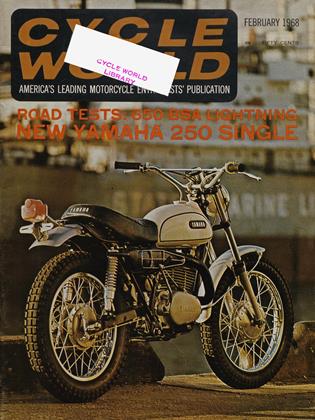MOTO BETA XC100
CYCLE WORLD TRAIL TEST
THE NEW BREED of ultra-lightweight, 100cc cross-country bikes has introduced a completely fresh section of the motorcycling public to competition riding.
Riders who would have been more than faintly chicken at the thought of hustling 300 lb. of 650-cc Triumph across the desert have no qualms whatsoever at the thought of cross-country racing on a bike so light that they could practically pick it up and run with it.
Typical of the new breed is the 100-cc Moto Beta, an Italian two-stroke built especially for export to the United States.
Two versions are available ; one is a trail bike complete with lights . . . just a fun bike for bashing about in the boonies.
The other is the XC100 — the subject of this impression report — and it’s every bit a racer.
All the lighting equipment has been dumped, and it has hotter port timing plus a full-race expansion chamber exhaust.
It runs in what has now become a hot class in scrambles racing, and faces competition from hopped-up Hodakas, Yamahas and any number of other flyweights.
Despite the competition, the Moto Beta invariably gives a good account of itself. It’s not an every time winner, but there’s usually an XC100 up among the front runners at most meetings.
Handling is one of the bike’s best features. Ceriani-type front forks, a scaleddown version of those used by the aces in European motocross, give around 4 in. of progressively damped movement. Their lateral rigidity is a great help toward the bike’s precise steering. There is none of the flexing which occurs with some lightweight telescopic forks over rough surfaces.
Riding position of the XC100 is basically comfortable. Handlebars, seat and footrests are well positioned in relationship to one another. A few small details could be improved, however.
The absolutely straight, ball-ended levers would be better replaced by a pair of the normal, slightly curved variety, for example.
The brake pedal would be easier to use were it cranked slightly outw'ard away from the engine unit. The kickstarter pedal is very close to the rider’s calf.
The frame is a sturdily-constructed duplex cradle unit with single top and seat tubes. It’s really light and handles nicely. The rear shock-absorbers are truly mansized. They appear capable of doing a good job . . . and they are!
Pirelli 3.00-18 Motocross tires are standard. Their knobbly, herringbone tread pattern gives fabulous grip in anything from mud to deep sand.
Considering the port timing, the expansion chamber and the 15:1 compression ratio, the engine delivers quite a reasonable amount of torque. However, for frontrunning in motocross events the rider would be forced to make maximum use of the gearbox to keep the engine absolutely at the boil.
The Dellorto carburetor is fitted with a saucepan type air cleaner, which contains a wire mesh filter. It fits directly onto the carburetor and, though probably quite adequate enough for dry conditions, it could be vulnerable if deep water had to be forded.
Buyers of Moto Betas likely to encounter this type of hazard probably would save themselves a bit of trouble — and much embarrassment — by mounting the filter elsew'here, under the seat, for example, connected to the carburetor by a length of rubber hose.
With a 15:1 compression ratio, the engine obviously could run a little hot. The designers have obviated this by using truly large fins on the cylinder and the light alloy head.
The fuel tank is a bulky 3-gal. unit, ideal for long distance events, though scrambles riders may prefer something a trifle narrower.
However, points such as these do not detract from the basic design. The Moto Beta XC100 — perhaps slightly modified to suit the rider’s personal preferences — is the equal of nearly anything in its class.












